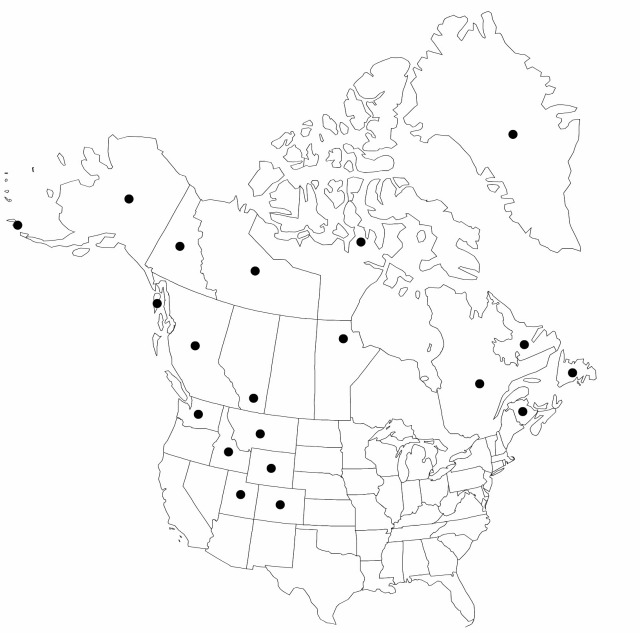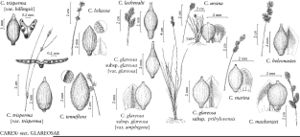Carex lachenalii
Beschr. Riedgräs. 1: 51, plate Y, fig. 79. 1801.
Plants ± loosely cespitose, in small clumps; rhizomes short. Culms weakly erect, sometimes slightly curving, 10–40 cm, smooth or nearly so. Leaves: sheaths pale brown abaxially, inner band hyaline, slightly red tinged, concave at summit; ligules short; blades mid to dark green, flat, 5–15 cm × 1–2 mm, usually shorter than culms. Inflorescences erect, 1–2.5 cm × 5–12 mm; proximal bracts scalelike, usually 2–8 mm, shorter than spikes. Spikes 2–5, lateral spikes gynecandrous, approximate or 1–2 proximal slightly separate, containing 10–20 perigynia, short-oblong to suborbicular. Pistillate scales red-brown with pale brown center and white-hyaline margins, oblong-ovate, subequaling perigynia, apex obtuse. Perigynia ascending, brownish green or in age brownish yellow, lightly or obscurely several-veined, obovate, 2–3.5 × 1–1.5 mm, base round-tapering, membranous; beak abaxial suture evident, entire or with few marginal teeth. Achenes pale to mid brown, elliptic, 1.2–1.5 × 1 mm, dull to slightly glossy. 2n = 64
Phenology: Fruiting Jul–Aug.
Habitat: Arctic and alpine meadows, peatlands, mossy banks of brooks
Elevation: 0–3700 m
Distribution

Greenland, Alta., B.C., Man., N.B., Nfld. and Labr., N.W.T., Nunavut, Que., Yukon, Alaska, Colo., Idaho, Mont., Utah, Wash., Wyo., Europe, Asia, New Zealand.
Discussion
Carex lachenalii shows a great deal of morphologic variation (e.g., some plants from Alaska with long perigynia and scales called C. lagopina var. longisquama Kükenthal); most variation has no evident taxonomic relevance. Short plants with relatively elongated beaks, described as C. bipartita var. austromontana F. J. Hermann seem to be geographically restricted to mountains of Colorado and Utah (F. J. Hermann 1970). Due to small and obscure differences, however, those plants are included here with some hesitation. Typical C. lachenalii also occurs in Colorado and Utah. Related species, C. furva Webb and C. co-optanda C. B. Clarke, which earlier were included in C. lachenalii occur in the mountains of Spain, Portugal, and Himalayas. The New Zealand plants represent an endemic subsp. parkeri (Petrie) Toivonen.
The name Carex bipartita Allioni has been widely used for the plant in North America. E. E. A. Janchen (1959) included that name as a rejected dubious name of Kobresia simpliciuscula (Wahlenberg) Mackenzie. The application of the name to Kobresia is due to L. H. Bailey (1889), who did so on the basis of specimens in Allioni’s herbarium. According to K. K. Mackenzie (1923), a Bellardi specimen matching Allioni’s plate and description is referable to C. lachenalii. If this is correct, there would appear to be no doubt that C. bipartita Allioni should replace C. lachenalii.
Selected References
None.
